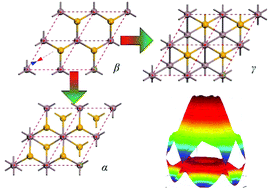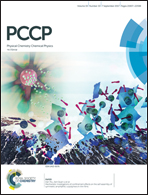Charging assisted structural phase transitions in monolayer InSe†
Abstract
A recently synthesized InSe monolayer exhibits highly promising electronic and transport properties; it also possesses intricate intralayer atomic bonding configurations that are conducive to modulations of crystal and electronic structures. Here we identify by first-principles calculations two new structural phases of monolayer InSe distinct from the experimentally synthesized β phase. The first, α phase, has the Se atom positions displaced relative to those in the β phase, and exhibits outstanding electronic properties similar to those of the β phase. The second, γ phase, has the In atom positions displaced, and displays exotic quantum spin Hall states in its electronic structure. Charging plays a crucial role in facilitating the transitions from the β phase to the α or γ phase, and it is also essential for stabilizing the two new phases. Electron injection, alkali metal adsorption, and coupling to the Ag(111) substrate all provide the charging effect that considerably lowers the energies of the new phases and the kinetic barriers of the transition pathways. The charging effect is particularly pronounced in lowering the kinetic barrier for the β-to-γ transition with a concomitant energy reduction stabilizing the γ phase that hosts Dirac cones in the electronic structure. The present results pave the way for further exploration and development of monolayer InSe as a versatile two-dimensional material for innovative device applications.



 Please wait while we load your content...
Please wait while we load your content...